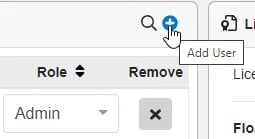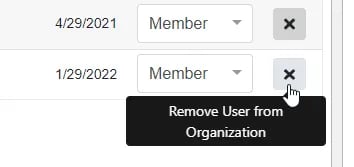Manage Users
Master user management in Admin Management to add, remove, and modify user roles efficiently.
Innoslate Admins have the capability to efficiently oversee user management within their organization, ensuring that users receive dedicated access to their Innoslate organization sandbox.

Managing Users
The Users Table displays the authorized users for the Organization, showcasing columns of users by Name, Username, Created Date and Role.

From this table, users may:
- Add/Remove a User
- Search for a User
- Assign their Organization Role
- Sort the columns by Name, Username, Created Date and Role (Organizational)
It is important to note that functionality from this table is ideal for smaller user management tasks. If onboarding multiple users and managing multiple license types in one session, then we suggest the License Dashboard.
Add/Remove a User
Add a User

1. Hover your cursor over the top right header of the User Table and select the 'Add User' icon![]() . The 'Add a User(s)' window will appear.
. The 'Add a User(s)' window will appear.

2. In the first field 'Users', enter desired user(s) by their username or email address. Note, after entering the username/email, hit enter. This will allow it to be captured by the form. Then continue typing to enter another user, if desired.
3. Select the 'License Type'.
4. Select their Organizational Role.
Organization Roles:
-
- The 'Admin' role provides them with access to the organization's Admin Dashboard, allowing them to administer the organization's users and access all projects, with owner privileges, created within the organization.
- The 'Member' role can create projects and view projects that have been shared with them.
- The 'Reviewer' role is automatically assigned to users who have a Reviewer license type and may only be granted Reviewer or Viewer roles on the project level. This role can also be granted to fully licensed users as needed.
Remove a User
1. Select the 'Remove User' icon in the desired User's row.

Search for a User
Organizational Admins can search for specific users within a Team on the Teams Dashboard.
1) Click on the Search icon on the Users table(![]() ), a search field will appear.
), a search field will appear.
2) Enter the username or email of the user to search for.
3a) To clear the search field and search for another user, simply click on the "X" next to the Search Field.
3b) Select "Close Search" to fully close the Search Field.
Watch the demonstration in the video provided below to see these steps in action.
To continue learning about Licenses and Users, Click Here.
(Next Article: Manage Project Roles)
